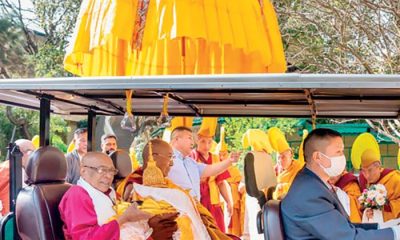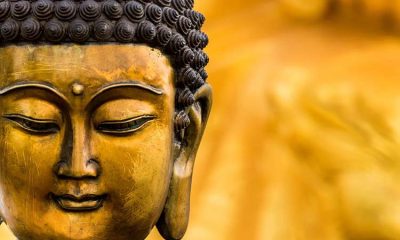Features
On first reading Sir Edwin Arnold’s THE LIGHT OF ASIA

By Rohana R. Wasala
Here endeth what I write
Who love the Master for his love of us.
A little knowing, little have I told
Touching the Teacher and the Ways of Peace
Forty-five rains thereafter showed he those
In many lands and many tongues, and gave
Our Asia Light, that still is beautiful,
Conquering the world with spirit of strong grace:
All which is written in the holy Books,
And where he passed, and what proud Emperors
Carved his sweet words upon the rocks and caves:
And how – in fulness of the times – it fell
The Buddha died, the great Tathagato,
Even as a man ‘mongst men, fulfilling all:
And how a thousand thousand lakhs since then
Have trod the Path which leads whither he went:
Unto NIRVANA, where the Silence lives.
AH! BLESSED LORD! OH, HIGH DELIVERER!
FORGIVE THIS FEEBLE SCRIPT, WHICH DOTH THEE WRONG
MEASURING WITH LITTLE WIT THY LOFTY LOVE.
AH! LOVER! BROTHER! GUID! LAMP OF THE LAW!
I TAKE MY REFUGE IN THY NAME AND THEE!
I TAKE MY REFUGE IN THY LAW OF GOOD!
I TAKE MY REFUGE IN THY ORDER! OM!
THE DEW IS ON THE LOTUS! – RISE GREAT SUN!
AND LIFT MY LEAF AND MIX ME WITH THE WAVE
OM MANI PADME HUM, SUNRISE COMES!
THE DEWDROP SLIPS TO THE SHINING SEA!
Edwin Arnold belonged to the group of Western intellectuals living at different times of the British Raj, who represented for us Sri Lankan islanders and Indian sub-continentals the mellowed humane face of British colonialism. They rendered yeoman service to both nations by stimulating historical and cultural awareness about themselves, which contributed to their eventual achievement of independence from foreign rule. German philologist, orientalist and great Buddhist scholar Frederick Max Muller (1823-1900), former American military officer, journalist, lawyer and theosophist Colonel Henry Steel Olcott (1832-1907), British Pali and Oriental scholar T.W. Rhys Davids (1843-1922), German orientalist and historian Wilhelm Geiger (1856-1943), German educationist Marie Museus Higgins (1855-1926), and a number of other noble men and women similarly inspired by a selfless love of humanity were of particular importance to us Sri Lankans.
Edwin Arnold, who was of the same age as Olcott, was born at Gravesend, Gravesham, Kent, England on June 10, 1832. As an undergraduate of Oxford University, he won the Newdigate prize for poetry in 1852. Having earned an MA, he left Oxford to become a school teacher at King Edwards School, Birmingham. Then, Arnold went to India in 1856 as Principal of Deccan College at Poona (Pune, today).
While working in India, he learned Sanskrit. Having lived a constantly active life of just over seventy years as poet, scholar, author, educator, and journalist, he died on March 24, 1904, in London England. Though he remained loyal to the British Empire throughout his life, he was free from the entrenched patronising or worse attitude of the average colonialist of the time towards the native imperial subjects including the Ceylonese (Sri Lankans) and treated them as equals.
The poem about ‘the life and teaching of Gautama’ (Buddha) The Light of Asia or The Great Renunciation’ that Arnold composed was first published in July 1879. In his preface to the book, he wrote that it …”is inspired by an abiding desire to aid in the better mutual knowledge of East and West. The time may come, I hope, when this book and my Indian Song of Songs, and Indian Idylls, will preserve the memory of one who loved India and the Indian peoples.” The Indian Song of Songs is the English translation of the 12th century CE Sanskrit poet Jayadeva’s epic poem Gita Govinda. Though supercharged with eroticism and replete with sensuous imagery, it is religious in terms of its central theme of Bhakti-yoga of Hinduism.
(‘Bhakti-yoga/pure devotional service to Lord Krishna as the highest and most expedient means for attaining pure love for Krishna, which is the highest end of spiritual existence’ in Hinduism, as Swami Bhaktivedanta Prabhupada explains in his 1984 English interpretation of the Hindu sacred text the Gita: Bhagavad-gita As It Is’.) Jayadeva’s Gita Govinda describes the amorous relationship between Krishna in the form of young Govinda and the beautiful cowherdess Radha. Krishna is the eighth incarnation of Vishnu (the Preserver and the Protector of the universe in the Hindu religion), so Govinda is another name for Vishnu. Hindus venerate Buddha as the ninth avatar (incarnation) of Vishnu. Arnold did his translation of the Gita Govinda in 1875, that is, four years before he wrote and published The Light of Asia. He also translated the Bhagavad-Gita as The Song Celestial (1885), which he dedicated to India at the opening, having written it, as he claimed, For England, O our India! as dear to me as She!”
This digression about Jayadeva is because I believe that Arnold’s experience with the Gita Govinda had a strong bearing on the literary quality of his own English epic poem The Light of Asia. I happened to read both The Light of Asia and the Sinhala version of the GitaGovinda entitled Govingu Geeya done by Sinhala scholar Arisen Ahubudu about the same time during my adolescent years. At the time I didn’t know that Arnold had translated the Sanskrit poem into English (as The Indian Song of Songs) before he crafted the English poem about the life and philosophy of the Buddha. Ahubudu provided each Sanskrit stanza in Sinhala transliteration with the Sinhala interpretation following it.
Jayadeva’s poem is rich in sensuous imagery; his frequent use of alliteration and assonance enhances its enchanting musicality. Through his rarely matched mastery of the Sinhala language Ahubudu produces an authentic translation of the original Sanskrit text. That Arnold’s familiarity with Jayadeva’s Gita Govinda influenced his composition of The Light of Asia, was something I was able to discern as a mature reader of the English poem years later. (As I write this, I have open before me a copy of The Light of Asia locally published in Ceylon (Sri Lanka) by the M.D. Gunasena & Co. Ltd, Colombo in 1954, which my father bought for me in Kandy for two rupees in 1962. It is the very copy that I read at 15+) that I am using here now after sixty-one years!
It carries an introductory essay under the title ‘The Buddha and His Teaching’ written by Dr G.P. Malalasekera of the University of Peradeniya. But it says nothing about the story of Buddha’s life except that he ‘was a human being who found supreme Enlightenment…’. I noticed its lopsidedness as an introduction to the book even at that young age. Obviously, the professor had not written it for The Light of Asia, but the publishers must have added it to make the publication seem more appealing and more accessible to the local reader. The whole essay is about Buddha’s teaching according to the Theravada tradition. This was what we were taught at school for the Buddhism subject in the Sinhala medium.
As we were learning English as a second language then, it was a big thing for me to be able to read Dr Malalasekera’s learned writing about Buddhism and understand it just as much as Arnold’s poem. However, the phrase ‘The Buddha and his teaching’ well describes the subject of Arnold’s The Light of Asia, which is mentioned in different words in several places in the text, including the final passage of the poem quoted at the opening of this essay: ‘Touching the Teacher and the Ways of Peace’; he lived and died ‘Even as a man ‘mongst men’. Arnold says as much of the Buddha’s life as of his teaching, as truthfully as he managed to understand it, shifting through the inevitable hyperbole that traditionally embellishes the historical narration of his life story, and the deliberate mystification that distorts the meaning of his profound doctrinal concepts.
The same edition contains Arnold’s own original Preface to his poem, which starts: ‘In the following Poem I have sought, by the medium of an imaginary Buddhist votary, to depict the life and character and indicate the philosophy of that noble hero and reformer, Prince Gautama of India, the founder of Buddhism.’ According to him, though little or nothing was known in Europe of ‘this great faith of Asia’ it had existed during twenty-four centuries, and at his time, surpassed in the number of its followers and the area of its prevalence, any other form of creed. Though Buddhism had for the most part had disappeared from India, the land of its birth, ‘the mark of Gautama’s sublime teaching is stamped ineffaceably upon modern Brahmanism, and the most characteristic habits and convictions of the Hindus are clearly due to the benign influence of Buddha’s precepts’.
‘More than a third of mankind… owe their moral and religious ideas to this illustrious prince; whose personality, though imperfectly revealed in the existing sources of information, cannot but appear the highest, gentlest, holiest, and most beneficent, with one exception, in the history of Thought….’ (I could infer who Arnold meant by this exception, but I thought that in his heart of hearts, he would have avoided that reservation, for his assertion sounded like nothing more than a concession to the dominant Christian sensitivities of his society.) Arnold quite rightly points out that though Gautama has been accorded superhuman status, he disapproved of ritual and ‘declared himself, even when on the threshold of Nirvana, to be only what all other men might become – the love and gratitude of Asia, disobeying his mandate, have given him fervent worship’.
(The phrase ‘on the threshold of Nirvana’ means, in more mundane words, ‘on his deathbed’; ‘on the threshold of Parinirvana’ is the usual way to put it. To put what Arnold hints at here differently: Siddhartha Gautama did not preach a religious system of ritual worship.) But ‘Forests of flowers are daily laid upon his stainless shrines, and countless millions of lips daily repeat the formula ‘I take refuge in the Buddha!’ Arnold observes with quiet adoration for the Sage whose memory still induces feelings of such pious devotion in the hearts of his followers.
Arnold stresses the historicity of the Buddha: ‘The Buddha of this poem – if, as need not be doubted, he really existed – was born on the borders of Nepaul about 620 B.C., and died about 543 B.C. at Kusinagara in Oudh.’ (These place names respectively are: Nepal, Kushinagar and Awadh or Avadh, today.) About the timeless relevance of Buddha’s teaching, he says: ‘… this venerable religion … has in it the eternity of a universal hope, the immortality of a boundless love, an indestructible element of faith in final good, and the proudest assertion ever made of human freedom.’
What Arnold next says in his original Preface has a message of vital importance to those who are concerned about the survival of the Buddha Sasana in Sri Lanka: ‘The extravaganzas which disfigure the record and practice of Buddhism are to be referred to that inevitable degradation which priesthoods always inflict upon great ideas committed to their charge. The power and sublimity of Gautama’s original doctrines should be estimated by their influence, not by their interpreters; nor by that innocent but lazy and ceremonious church which has arisen on the foundations of the Buddhistic Brotherhood or “Sangha”.’ Incidentally, it would be timely to consider whether or not ‘innocent but lazy and ceremonious’ is a good description of the present-day Buddhist church (= the clerical officialdom/the Mahanayake, Anunatake, Adhikarana Sangha Nayake, … system) in Sri Lanka.
Arnold has put his poem into the mouth of an imaginary Buddhist devotee ‘because, to appreciate the spirit of Asiatic thoughts, they should be regarded from the Oriental point of view; and neither miracles which consecrate this record, nor the philosophy which it embodies could have been otherwise so naturally reproduced. The doctrine of Transmigration, for instance – startling to modern minds – was established and thoroughly accepted by the Hindus of Buddha’s time….’ (Arnold is here referring to the then prevalent Western attitude to the idea of reincarnation or rebirth, which Hindus of the pre-Christian Buddha’s time took for granted, as Hindus and Buddhists still do.) He confesses that his exposition of the Buddha’s ancient doctrine is necessarily incomplete, since, in conformity with rules of poetic art, he has to pass by many philosophically most important matters developed over Gautama’s long ministry. But he would consider his purpose achieved, if he succeeded in communicating ‘any just conception ……of the lofty character of this noble prince, and of the general purport of his doctrines…’
(To be continued)
Features
People set example for politicians to follow

Some opposition political parties have striven hard to turn the disaster of Cyclone Ditwah to their advantage. A calamity of such unanticipated proportions ought to have enabled all political parties to come together to deal with this tragedy. Failure to do so would indicate both political and moral bankruptcy. The main issue they have forcefully brought up is the government’s failure to take early action on the Meteorological Department’s warnings. The Opposition even convened a meeting of their own with former President Ranil Wickremesinghe and other senior politicians who shared their experience of dealing with natural and man-made disasters of the past, and the present government’s failures to match them.
The difficulty to anticipate the havoc caused by the cyclone was compounded by the neglect of the disaster management system, which includes previous governments that failed to utilise the allocated funds in an open, transparent and corruption free manner. Land designated as “Red Zones” by the National Building Research Organisation (NBRO), a government research and development institute, were built upon by people and ignored by successive governments, civil society and the media alike. NBRO was established in 1984. According to NBRO records, the decision to launch a formal “Landslide Hazard Zonation Mapping Project (LHMP)” dates from 1986. The institutional process of identifying landslide-prone slopes, classifying zones (including what we today call “Red Zones”), and producing hazard maps, started roughly 35 to 40 years ago.
Indonesia, Thailand and the Philippines which were lashed by cyclones at around the same time as Sri Lanka experienced Cyclone Ditwah were also unprepared and also suffered enormously. The devastation caused by cyclones in the larger southeast Asian region is due to global climate change. During Cyclone Ditwah some parts of the central highlands received more than 500 mm of rainfall. Official climatological data cite the average annual rainfall for Sri Lanka as roughly 1850 mm though this varies widely by region: from around 900 mm in the dry zones up to 5,000 mm in wet zones. The torrential rains triggered by Ditwah were so heavy that for some communities they represented a rainfall surge comparable to a major part of their typical annual rainfall.
Inclusive Approach
Climate change now joins the pantheon of Sri Lanka’s challenges that are beyond the ability of a single political party or government to resolve. It is like the economic bankruptcy, ethnic conflict and corruption in governance that requires an inclusive approach in which the Opposition, civil society, religious society and the business community need to join rather than merely criticise the government. It will be in their self-interest to do so. A younger generation (Gen Z), with more energy and familiarity with digital technologies filled, the gaps that the government was unable to fill and, in a sense, made both the Opposition and traditional civil society redundant.
Within hours of news coming in that floods and landslides were causing havoc to hundreds of thousands of people, a people’s movement for relief measures was underway. There was no one organiser or leader. There were hundreds who catalysed volunteers to mobilise to collect resources and to cook meals for the victims in community kitchens they set up. These community kitchens sprang up in schools, temples, mosques, garages and even roadside stalls. Volunteers used social media to crowdsource supplies, match donors with delivery vehicles, and coordinate routes that had become impassable due to fallen trees or mudslides. It was a level of commitment and coordination rarely achieved by formal institutions.
The spontaneous outpouring of support was not only a youth phenomenon. The larger population, too, contributed to the relief effort. The Galle District Secretariat sent 23 tons of rice to the cyclone affected areas from donations brought by the people. The Matara District Secretariat made arrangements to send teams of volunteers to the worst affected areas. Just as in the Aragalaya protest movement of 2022, those who joined the relief effort were from all ethnic and religious communities. They gave their assistance to anyone in need, regardless of community. This showed that in times of crisis, Sri Lankans treat others without discrimination as human beings, not as members of specific communities.
Turning Point
The challenge to the government will be to ensure that the unity among the people that the cyclone disaster has brought will outlive the immediate relief phase and continue into the longer term task of national reconstruction. There will be a need to rethink the course of economic development to ensure human security. President Anura Kumara Dissanayake has spoken about the need to resettle all people who live above 5000 feet and to reforest those areas. This will require finding land for resettlement elsewhere. The resettlement of people in the hill country will require that the government address the issue of land rights for the Malaiyaha Tamils.
Since independence the Malaiyaha Tamils have been collectively denied ownership to land due first to citizenship issues and now due to poverty and unwillingness of plantation managements to deal with these issues in a just and humanitarian manner beneficial to the workers. Their resettlement raises complex social, economic and political questions. It demands careful planning to avoid repeating past mistakes where displaced communities were moved to areas lacking water, infrastructure or livelihoods. It also requires political consensus, as land is one of the most contentious issues in Sri Lanka, tied closely to identity, ethnicity and historical grievances. Any sustainable solution must go beyond temporary relocation and confront the historical exclusion of the Malaiyaha Tamil community, whose labour sustains the plantation economy but who remain among the poorest groups in the country.
Cyclone Ditwah has thus become a turning point. It has highlighted the need to strengthen governance and disaster preparedness, but it has also revealed a different possibility for Sri Lanka, one in which the people lead with humanity and aspire for the wellbeing of all, and the political leadership emulates their example. The people have shown through their collective response to Cyclone Ditwah that unity and compassion remain strong, which a sincere, moral and hardworking government can tap into. The challenge to the government will be to ensure that the unity among the people that the cyclone disaster has brought will outlive the immediate relief phase and continue into the longer term task of national reconstruction with political reconciliation.
by Jehan Perera
Features
An awakening: Revisiting education policy after Cyclone Ditwah

 In the short span of two or three days, Cyclone Ditwah, has caused a disaster of unprecedented proportions in our midst. Lashing away at almost the entirety of the country, it has broken through the ramparts of centuries old structures and eroded into areas, once considered safe and secure.
In the short span of two or three days, Cyclone Ditwah, has caused a disaster of unprecedented proportions in our midst. Lashing away at almost the entirety of the country, it has broken through the ramparts of centuries old structures and eroded into areas, once considered safe and secure.
The rains may have passed us by. The waters will recede, shops will reopen, water will be in our taps, and we can resume the daily grind of life. But it will not be the same anymore; it should not be. It should not be business as usual for any of us, nor for the government. Within the past few years, Sri Lankan communities have found themselves in the middle of a crisis after crisis, both natural and man-made, but always made acute by the myopic policies of successive governments, and fuelled by the deeply hierarchical, gendered and ethnicised divides that exist within our societies. The need of the hour for the government today is to reassess its policies and rethink the directions the country, as a whole, has been pushed into.
Neoliberal disaster
In the aftermath of the devastation caused by the natural disaster, fundamental questions have been raised about our existence. Our disaster is, in whole or in part, the result of a badly and cruelly managed environment of the planet. Questions have been raised about the nature of our economy. We need to rethink the way land is used. Livelihoods may have to be built anew, promoting people’s welfare, and by deveoloping a policy on climate change. Mega construction projects is a major culprit as commentators have noted. Landslides in the upcountry are not merely a result of Ditwah lashing at our shores and hills, but are far more structural and points to centuries of mismanagement of land. (https://island.lk/weather-disasters-sri-lanka-flooded-by-policy-blunders-weak-enforcement-and-environmental-crime-climate-expert/). It is also about the way people have been shunted into lands, voluntarily or involuntarily, that are precarious, in their pursuit of a viable livelihood, within the limited opportunities available to them.
Neo liberal policies that demand unfettered land appropriation and built on the premise of economic growth at any expense, leading to growing rural-urban divides, need to be scrutinised for their short and long term consequences. And it is not that any of these economic drives have brought any measure of relief and rejuvenation of the economy. We have been under the tyrannical hold of the IMF, camouflaged as aid and recovery, but sinking us deeper into the debt trap. In October 2025, Ahilan Kadirgamar writes, that the IMF programme by the end of 2027, “will set up Sri Lanka for the next crisis.” He also lambasts the Central Bank and the government’s fiscal policy for their punishing interest rates in the context of disinflation and rising poverty levels. We have had to devalue the rupee last month, and continue to rely on the workforce of domestic workers in West Asia as the major source of foreign exchange. The government’s negotiations with the IMF have focused largely on relief and infrastructure rebuilding, despite calls from civil society, demanding debt justice.
The government has unabashedly repledged its support for the big business class. The cruelest cut of them all is the appointment of a set of high level corporate personalities to the post-disaster recovery committee, with the grand name, “Rebuilding Sri Lanka.” The message is loud and clear, and is clearly a slap in the face of the working people of the country, whose needs run counter to the excessive greed of extractive corporate freeloaders. Economic growth has to be understood in terms that are radically different from what we have been forced to think of it as, till now. For instance, instead of investment for high profits, and the business of buy and sell in the market, rechannel investment and labour into overall welfare. Even catch phrases like sustainable development have missed their mark. We need to think of the economy more holistically and see it as the sustainability of life, livelihood and the wellbeing of the planet.
The disaster has brought on an urgency for rethinking our policies. One of the areas where this is critical is education. There are two fundamental challenges facing education: Budget allocation and priorities. In an address at a gathering of the Chamber of Commerce, on 02 December, speaking on rebuilding efforts, the Prime Minister and Minister of Education Dr. Harini Amarasuriya restated her commitment to the budget that has been passed, a budget that has a meagre 2.4% of the GDP allocated for education. This allocation for education comes in a year that educational reforms are being rolled out, when heavy expenses will likely be incurred. In the aftermath of the disaster, this has become more urgent than ever.
Reforms in Education
The Government has announced a set of amendments to educational policy and implementation, with little warning and almost no consultation with the public, found in the document, Transforming General Education in Sri Lanka 2025 published by the Ministry of Education. Though hailed as transformative by the Prime Minister (https://www.news.lk/current-affairs/in-the-prevailing-situation-it-is-necessary-to-act-strategically-while-creating-the-proper-investments-ensuring-that-actions-are-discharged-on-proper-policies-pm), the policy is no more than a regurgitation of what is already there, made worse. There are a few welcome moves, like the importance placed on vocational training. Here, I want to raise three points relating to vital areas of the curriculum that are of concern: 1) streamlining at an early age; relatedly 2) prioritising and privileging what is seen as STEM education; and 3) introducing a credit-based modular education.
1. A study of the policy document will demonstrate very clearly that streamlining begins with Junior Secondary Education via a career interest test, that encourages students to pursue a particular stream in higher studies. Further Learning Modules at both “Junior Secondary Education” and “Senior Secondary Education Phase I,” entrench this tendency. Psychometric testing, that furthers this goal, as already written about in our column (https://kuppicollective.lk/psychometrics-and-the-curriculum-for-general-education/) points to the bizarre.
2. The kernel of the curriculum of the qualifying examination of Senior Secondary Education Phase I, has five mandatory subjects, including First Language, Math, and Science. There is no mandatory social science or humanities related subject. One can choose two subjects from a set of electives that has history and geography as separate subjects, but a Humanities/Social Science subject is not in the list of mandatory subjects. .
3. A credit-based, modular education: Even in universities, at the level of an advanced study of a discipline, many of us are struggling with module-based education. The credit system promotes a fragmented learning process, where, depth is sacrificed for quick learning, evaluated numerically, in credit values.
Units of learning, assessed, piece meal, are emphasised over fundamentals and the detailing of fundamentals. Introducing a module based curriculum in secondary education can have an adverse impact on developing the capacity of a student to learn a subject in a sustained manner at deeper levels.
Education wise, and pedagogically, we need to be concerned about rigidly compartmentalising science oriented, including technological subjects, separately from Humanities and Social Studies. This cleavage is what has led to the idea of calling science related subjects, STEM, automatically devaluing humanities and social sciences. Ironically, universities, today, have attempted, in some instances, to mix both streams in their curriculums, but with little success; for the overall paradigm of education has been less about educational goals and pedagogical imperatives, than about technocratic priorities, namely, compartmentalisation, fragmentation, and piecemeal consumerism. A holistic response to development needs to rethink such priorities, categorisations and specialisations. A social and sociological approach has to be built into all our educational and development programmes.
National Disasters and Rebuilding Community
In the aftermath of the disaster, the role of education has to be rethought radically. We need a curriculum that is not trapped in the dichotomy of STEM and Humanities, and be overly streamlined and fragmented. The introduction of climate change as a discipline, or attention to environmental destruction cannot be a STEM subject, a Social Science/Humanities subject or even a blend of the two. It is about the vision of an economic-cum-educational policy that sees the environment and the economy as a function of the welfare of the people. Educational reforms must be built on those fundamentals and not on real or imagined short term goals, promoted at the economic end by neo liberal policies and the profiteering capitalist class.
As I write this, the sky brightens with its first streaks of light, after days of incessant rain and gloom, bringing hope into our hearts, and some cheer into the hearts of those hundreds of thousands of massively affected people, anxiously waiting for a change in the weather every second of their lives. The sense of hope that allows us to forge ahead is collective and social. The response by Lankan communities, to the disaster, has been tremendously heartwarming, infusing hope into what still is a situation without hope for many. This spirit of collective endeavour holds the promise for what should be the foundation for recovery. People’s demands and needs should shape the re-envisioning of policy, particularly in the vital areas of education and economy.
(Sivamohan Sumathy was formerly attached to the Department of English, University of Peradeniya)
Kuppi is a politics and pedagogy happening on the margins of the lecture hall that parodies, subverts, and simultaneously reaffirms social hierarchies.
By Sivamohan Sumathy
Features
ABBA scene in Doha … Ishini in the spotlight

 The group ABBA, from Sweden, officially disbanded in 1982, and that made room for several ABBA imitators to come into the scene.
The group ABBA, from Sweden, officially disbanded in 1982, and that made room for several ABBA imitators to come into the scene.
What’s more, ABBA tribute concerts are also turning out to be popular with music lovers who still appreciate, and enjoy, the music of ABBA.
With this in mind, Treffen House Hotel, in Doha, decided to put together a series of ABBA Tribute Concerts which were held, in the hotel itself, on 27th, 28th and 29th November, 2025.
To do the needful, on stage, they selected our very own Ishini Fonseka and her participation certainly did highlight the global appeal of ABBA’s music and the talent of Sri Lankan artistes.
The tribute shows brought the magic of ABBA’s hits to the audience,

On stage belting out the ABBA hits
Backed by a Sri Lankan band, the Vibes, based in Qatar, Ishini was in the spotlight for one hour, each night, belting out the hits of ABBA.
She also obliged the audience, from various nationalities, with a few hit songs in Hindi, Tamil and Sinhala.
Her repertoire included the best of ABBA hits, such as ‘Mamma Mia’, ‘Dancing Queen’, ‘Chiquitita’ and many more.
Being a multi-instrumentalist, she also played the piano, and guitar, as well, while singing some of the beautiful ABBA songs.
The three-day concert was a part of a Sri Lankan food festival, held at the hotel, in which several unique Sri Lankan cuisines were promoted internationally.
The event’s main sponsor was Prime Lands, and the event focused on the importance of investing on Real Estate, especially since the foreign currency sent to Sri Lanka benefits the country’s economy vastly.
Kumudu Fonseka, the General Manager of Treffen House Hotel, the main man behind the spectacular three-day Sri Lankan Food Festival, I’m told, is very keen to highlight the uniqueness of Sri Lanka.
He also has plans to put together a charity concert to raise funds for the people in Sri Lanka, affected by Cyclone Ditwah.
The Chief Guest, on the second day, was the Ambassador of Sri Lanka, who personally appreciated and admired Ishini Fonseka for bringing back her childhood memories of ABBA.
Ishini was involved in three other events, at the hotel, as a guest star, before returning home.
Her next foreign assignment is to the Maldives, on 22nd December, with her band Ishini & The Branch.
She will be doing the Christmas and New Year’s Eve scene in the Maldives and will be back, in Sri Lanka, on 02nd January 2026.
-
News6 days ago
Lunuwila tragedy not caused by those videoing Bell 212: SLAF
-

 News1 day ago
News1 day agoOver 35,000 drug offenders nabbed in 36 days
-

 News5 days ago
News5 days agoLevel III landslide early warning continue to be in force in the districts of Kandy, Kegalle, Kurunegala and Matale
-

 Business3 days ago
Business3 days agoLOLC Finance Factoring powers business growth
-

 News3 days ago
News3 days agoCPC delegation meets JVP for talks on disaster response
-

 News3 days ago
News3 days agoA 6th Year Accolade: The Eternal Opulence of My Fair Lady
-

 News1 day ago
News1 day agoRising water level in Malwathu Oya triggers alert in Thanthirimale
-

 Midweek Review6 days ago
Midweek Review6 days agoHouse erupts over Met Chief’s 12 Nov unheeded warning about cyclone Ditwah

























